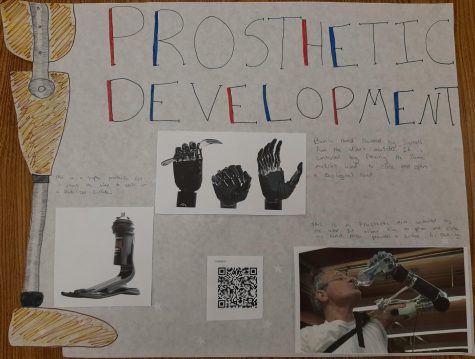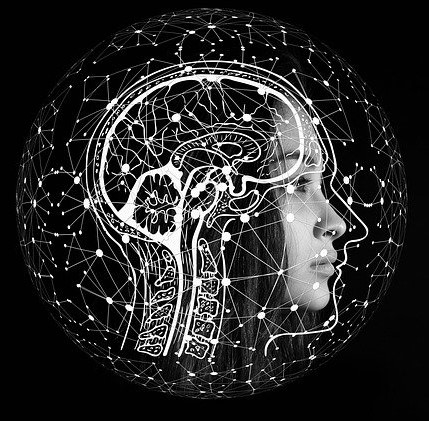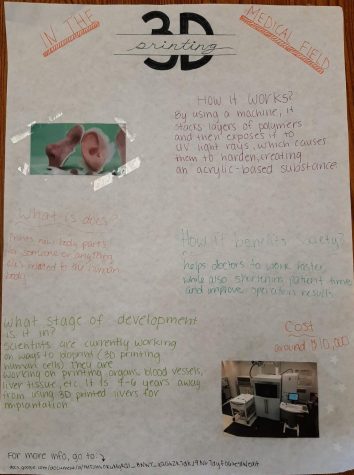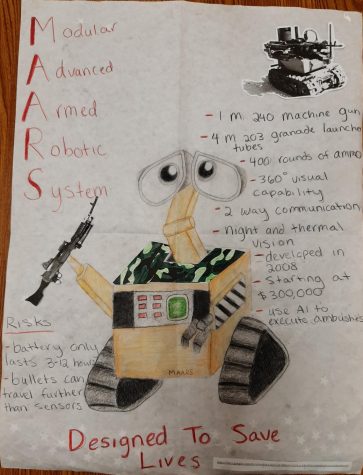The Most Interesting Technology
Science & Society Class Explores the Future
3D Printing. Prosthetic development. MAARS. Wait, where are we going?
Last week in Mrs. Stantesly’s senior Science & Society class, students chose technology topics to research and “sell” as the most interesting technologies that exist today. View the top three groups’ presentations below.
The 3D printing, specifically for medical, prints new body parts for someone or anything else related to the human body. It was first discovered in 1983 when Charles Hull was working for a company that made UV lights and household items. Then he discovered that when polymers are exposed to UV rays, they harden into an acrylic-based substance. He created a machine that stacked layers of the acrylic polymers with a UV laser. After Hull sold the 3d printer, it’s very first use was in the medical field printing things for dental implants and prosthetics.
Today, scientists around the world are currently working on ways to bioprint, meaning the 3d printing of human cells. They are researching ways to 3D print organs, parts of organs, blood vessels, and and have even 3D printed human liver tissue available for commercial use. It is believed that they are only 4-6 years away from 3D printing partial livers for human implantation. As a result, the 3D printing will benefit society by first helping doctors to work faster, while also shortening patient time and improve operation results. Patients could now experience improved quality of care through 3D printed implants and prosthetics. Another benefit with 3D printers is that it’s cheaper than typical transplants. According to Forbes, “The typical kidney transplant, for instance, costs an average of $330,000, according to the National Foundation for Transplants. The conventional 3D bioprinter, on the other hand, retails for just $10,000,” (Pando). This would help patients, economically, to get good and effective procedures done. However, the downside of medical 3D printing is the exposure to dangerous particles. According to “The Risks of 3D Printing”, “exposure to ultrafine particles (UFPs) – Printers without proper ventilation can expose users to the UFPs that are released during the printing process. Inhaled UFPs can cause adverse health effects, including an increased risk of asthma, heart disease, and stroke,” (Scirocco Group Insurance). The risks of medical 3D printing can negatively affect patients with their health conditions.
Overall, medical 3D printers are a huge accomplishment that was introduced in the medical field to help patients.
MAARS stands for the Modular Advanced Armed Robotic System. It is a robot that was designed to keep human fighters at a safe distance from enemy fire while successfully executing their missions. The first generation of MAARS robots was deployed in June 2008. Now over 10 years later many upgrades have been performed. It is an unmanned ground vehicle (UGV) that is armed with an M24OB machine gun, four M2O3 grenade launchers tubes and it can carry up to 400 rounds of ammunition, It has a 360-degree visual capability, two-way communication, night and thermal visions and the vehicle is also fitted with lasers.
The MAARS robot can benefit society by reducing human casualties. It uses it’s built-in AI to execute ambushes, perform forced entries, and enter booby-trapped areas. It can make faster decisions than humans and be unaffected by anger, revenge, hunger, fear, fatigue, or stress. It is able to drag wounded soldiers off the battlefield and it is not affected by tough terrain. There are some risks identified by using the MAARS robot. The battery only actively lasts between 3 and 12 hours before needing to be recharged depending on the tasks it performs. Collateral damage is a concern also because its machine gun bullets can travel further than the sensors on the robot. The cost for a MAARS robot using the base platform is $300,000.
 A prosthetic is an artificial limb that is used to either help in rehabilitation or to help replace a lost limb. Prosthetics were first developed in 1975 by Ysidro M. Martinez. It was the first lightweight solution for a below knee prosthetic to allow people with lost limbs to live a more independent lifestyle. Prosthetics increase a person’s independence and reduces the need of a caretaker. The purpose of getting a prosthetic (artificial limb) is to help that person perform daily activities such as walking, running, exercising, etc. Prosthetics benefit society by granting disabled people greater independence and reducing the amount of disabled people. Prosthetics are a field rapidly developing life changing technology. In the past, artificial limbs were just for looks and didn’t necessarily improve multiple daily life tasks. With today’s technology, prosthetics can move and perform daily tasks and pick up signals from the user’s muscles. The newest and most expensive prosthetics movement can be controlled by the mind. This revolutionary technology is currently being sold for $120 million.
A prosthetic is an artificial limb that is used to either help in rehabilitation or to help replace a lost limb. Prosthetics were first developed in 1975 by Ysidro M. Martinez. It was the first lightweight solution for a below knee prosthetic to allow people with lost limbs to live a more independent lifestyle. Prosthetics increase a person’s independence and reduces the need of a caretaker. The purpose of getting a prosthetic (artificial limb) is to help that person perform daily activities such as walking, running, exercising, etc. Prosthetics benefit society by granting disabled people greater independence and reducing the amount of disabled people. Prosthetics are a field rapidly developing life changing technology. In the past, artificial limbs were just for looks and didn’t necessarily improve multiple daily life tasks. With today’s technology, prosthetics can move and perform daily tasks and pick up signals from the user’s muscles. The newest and most expensive prosthetics movement can be controlled by the mind. This revolutionary technology is currently being sold for $120 million.
As with any piece of technology, there are risks and downsides with prosthetics. The most obvious being the cost. The most common prosthetics cost anywhere from $5,000-$50,000 and the mind controlled models costing upwards of $120 million. To add to this, prosthetics are not a one time cost. Due to the human body constantly changing its shape and size, the average prosthetic only lasts about 3 years. Along with a hefty price tag, prosthetics can also be uncomfortable at times. Repeated use and changes in muscle can alter the fit of the artificial limb and then cause pain and soreness.
Which topic do you find most interesting? Vote for your favorite at our poll below.








